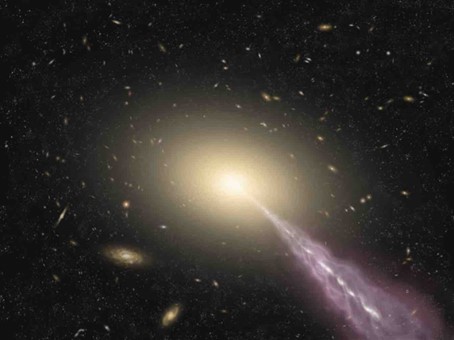Using the Atacama Large Millimeter/submillimeter Array (ALMA) in Chile, a team of astronomers led by Shinya Komugi of Kogakuin University has discovered for the first time a faint radio emission covering a giant galaxy with an energetic black hole at its center. The radio emission is released from gas that is created directly by the central black hole. The result was obtained through high dynamic range imaging techniques.
The team expects to understand how a black hole interacts with its host galaxy by applying the same technique to other quasars.
Artist’s impression of a giant galaxy with a high-energy jet. Image credit: ALMA (ESO/NAOJ/NRAO).
3C273, which lies at a distance of 2.4 billion light-years from Earth, is a quasar. A quasar is the nucleus of a galaxy believed to house a massive black hole at its center. Black holes swallow their surrounding gas, but the surrounding gas on the brink of being eaten by the black hole gives off an enormous amount of radiation. This makes quasars one of the brightest objects in the sky. Contrary to its bland name, 3C273 is the very first quasar ever discovered, the brightest, and the best studied. As such, it is one of the most frequently observed sources with telescopes because it can be used as a standard of position in the sky: in other words, 3C273 is a radio lighthouse.
When you see the headlight of a car, the dazzling brightness makes it difficult to see the darker surroundings. The same thing happens to telescopes when you observe bright objects. The contrast between the brightest and darkest tones in an image is called dynamic range. To reveal both the bright and dark parts in a telescope’s single shot, you need high dynamic range. ALMA can regularly attain imaging dynamic ranges up to around 100, but commercially available digital cameras would normally have a dynamic range of several thousands. Radio telescopes aren’t very good at seeing objects with large contrast.
3C273 has been known for decades as the most famous quasar, but knowledge has been concentrated on its bright central nuclei where most of the radio waves come from. Much less has been known about its host galaxy itself, however, because the combination of the faint and diffuse galaxy with the 3C273 nucleus required such high dynamic ranges to detect. The research team used a technique called self-calibration to reduce the leakage of radio waves from 3C273 to the galaxy image, which used 3C273 itself to correct for the effects of earth’s atmospheric fluctuations on the telescope system. They reached an imaging dynamic range of 85000, an ALMA record for extragalactic objects.

Quasar 3C273 observed by the Hubble Space Telescope (HST) (left) [1][2]. The exceeding brightness results in radial leaks of light, created by light scattered by the telescope. At the lower right is a high-energy jet released by the gas around the central black hole. Radio image of 3C273 observed by ALMA, showing the faint and extended radio emission (in blue-white color) around the nucleus (right). The bright central source has been subtracted from the image. The same jet as the image on the left can be seen in orange. Image credit: Komugi et al., NASA/ESA Hubble Space Telescope
As a result of achieving high imaging dynamic range, the team discovered the faint radio emission extending for tens of thousands of light-years over the host galaxy of 3C273. Radio emission around quasars normally suggests that it is synchrotron emission, which comes from highly energetic events like bursts of star formation or ultra-fast jets emanating from the central nucleus. A synchrotron jet exists in 3C273 as well, seen in the lower right of the images. An important characteristic of synchrotron emission is that its brightness changes with frequency, but the faint radio emission discovered by the team had constant brightness irrespective of the radio frequency. After considering alternative mechanisms, the team found that this faint and extended radio emission came from hydrogen gas in the galaxy that was energized directly by the 3C273 nucleus. This is the first time that radio waves from such a mechanism are found to extend for tens of thousands of light-years in the host galaxy of a quasar. Astronomers had overlooked this phenomenon for decades in this iconic cosmic lighthouse.
So why is this discovery so important? It has been a big mystery in galactic astronomy whether the energy from a quasar nucleus can be strong enough to deprive the galaxy’s ability to form stars. The faint radio emission may help to solve it. Hydrogen gas is an essential ingredient to form stars, but if such a strong light shines on it that the gas is disassembled (ionized), no stars can be born. To study whether this process is happening around quasars, astronomers have used optical light emitted by ionized gas. The problem working with optical light is that cosmic dust absorbs the light along the way to the telescope, so it is difficult to know how much light the gas gave off. Moreover, the mechanism responsible for giving off optical light is complex, forcing astronomers to make a lot of assumptions. The radio waves discovered in this study come from the same gas due to simple processes and are not absorbed by dust. Using radio waves makes it that much easier to measure ionized gas created by 3C273’s nucleus. In this study, the astronomers found that at least 7% of the light from 3C273 was absorbed by gas in the host galaxy, creating ionized gas amounting to 10-100 billion times the mass of the sun. However, 3C273 had a lot of gas just before the formation of stars, so as a whole, it didn’t look like star formation was strongly suppressed by the nucleus.
“This discovery provides a new avenue to studying problems previously tackled using observations by optical light,” says Shinya Komugi, an associate professor at Kogakuin University and lead author of the study published in the Astrophysical Journal. “By applying the same technique to other quasars, we expect to understand how a galaxy evolves through its interaction with the central nucleus.”
Additional information
The research was presented in the Astrophysical Journal on April 28, 2022.
URL: https://iopscience.iop.org/article/10.3847/1538-4357/ac616e
Title: Detection of extended millimeter emission in the host galaxy of 3C273 and its implications for QSO feedback via high dynamic range ALMA imaging
Authors: Shinya. Komugi (Kogakuin University), Yoshiki Toba (National Astronomical Observatory of Japan [NAOJ]), Yoshiki Matsuoka (Ehime University), Toshiki Saito (NAOJ), and Takuji Yamashita (NAOJ)
DOI: 10.3847/1538-4357/ac616e
The team is composed of Shinya Komugi (Kogakuin University), Yoshiki Toba (National Astronomical Observatory of Japan [NAOJ]), Yoshiki Matsuoka (Ehime University), Toshiki Saito (NAOJ), and Takuji Yamashita (NAOJ).
This research was supported by JSPS KAKENHI Grant Numbers JP20K04015, JP21K13968, and JP19K14759.
The Atacama Large Millimeter/submillimeter Array (ALMA), an international astronomy facility, is a partnership of the European Organisation for Astronomical Research in the Southern Hemisphere (ESO), the U.S. National Science Foundation (NSF) and the National Institutes of Natural Sciences (NINS) of Japan in cooperation with the Republic of Chile. ALMA is funded by ESO on behalf of its Member States, by NSF in cooperation with the National Research Council of Canada (NRC) and the Ministry of Science and Technology (MOST) and by NINS in cooperation with the Academia Sinica (AS) in Taiwan and the Korea Astronomy and Space Science Institute (KASI). ALMA construction and operations are led by ESO on behalf of its Member States; by the National Radio Astronomy Observatory (NRAO), managed by Associated Universities, Inc. (AUI), on behalf of North America; and by the National Astronomical Observatory of Japan (NAOJ) on behalf of East Asia. The Joint ALMA Observatory (JAO) provides the unified leadership and management of the construction, commissioning and operation of ALMA.
National Astronomical Observatory of Japan (NAOJ):
Notes
[1] Based on observations made with the NASA/ESA Hubble Space Telescope, and obtained from the Hubble Legacy Archive, which is a collaboration between the Space Telescope Science Institute (STScI/NASA), the Space Telescope European Coordinating Facility (ST-ECF/ESA) and the Canadian Astronomy Data Centre (CADC/NRC/CSA). [2] Both HST and ALMA images are three-color composite images created using the method outlined by Lupton et al. (2004), “Preparing Red-Green-Blue Images from CCD Data”, in the Publication of the Astronomical Society of the Pacific (DOI: 10.1086/382245).■About KOGAKUIN University
Kogakuin University was initially founded in 1887. It was the first private engineering school established in Japan to train engineers who would work on the front lines of the industries that were needed for promoting Japan’s modernization. Its graduates are particularly active in the fields of engineering and architecture.
Kogakuin University has several research institutes, supported by financial assistance from the Ministry of Education, Culture, Sports, Science and Technology, and encourages joint research with corporate partners.









